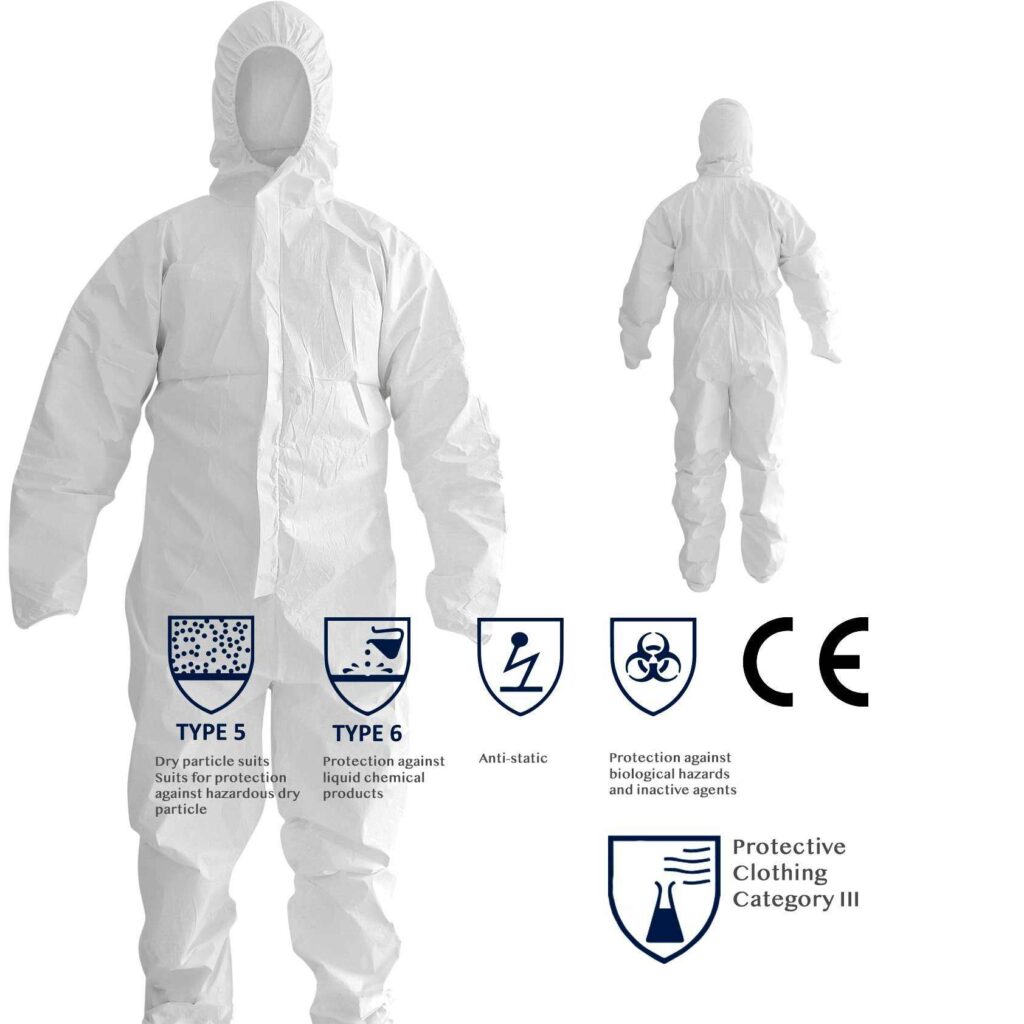Disposable coveralls are essential personal protective equipment (PPE) designed to protect workers from various hazards in different working environments. They provide barrier protection against particulates, liquids, and chemicals, ensuring safety and hygiene. The classification of these coveralls into Types 3, 4, 5, and 6 is based on the level and type of protection they offer according to international standards such as the European Norms (EN).
Below is a detailed introduction to each type of disposable coverall, including their features, protection levels, and typical applications.

Type 3 Disposable Coveralls
Definition
Type 3 coveralls offer liquid-tight protection, safeguarding the wearer against strong jets of liquid chemicals. They are designed to provide a hermetic barrier, preventing any liquid penetration even under pressure.
Key Features
- Sealed Seams: Utilizes welded or taped seams to ensure complete liquid-tightness.
- Chemical Resistance: Made from materials resistant to a wide range of chemicals.
- Hooded Design: Often includes a hood to protect the head and neck areas.
- Elastic Closures: Features elastic wrists, ankles, and waist for a secure fit and enhanced protection.
- Durability: Constructed to withstand harsh working conditions and repeated movements.
Protection Level
- Liquid Chemicals: Provides high-level protection against pressurized liquid chemicals.
- Biological Hazards: Offers barrier protection against biological contaminants and pathogens.
Typical Applications
- Chemical Industry: Handling and transferring hazardous chemicals.
- Emergency Response: Dealing with chemical spills and contamination control.
- Pharmaceutical Manufacturing: Working in environments where exposure to liquid chemicals is prevalent.
- Industrial Cleaning: High-pressure cleaning tasks involving hazardous substances.
Type 4 Disposable Coveralls
Definition
Type 4 coveralls provide spray-tight protection, protecting the wearer against liquid aerosols and light sprays of chemicals. They are suitable for situations where there is a risk of exposure to liquid sprays but not necessarily high-pressure jets.
Key Features
- Sealed or Taped Seams: Ensures that liquids do not penetrate through seam lines.
- Breathable Materials: Often made from fabrics that allow for airflow, increasing comfort during extended use.
- Ergonomic Design: Designed for ease of movement and reduced fatigue.
- Integrated Hood: Protects the head and neck from splashes and sprays.
- Elasticized Ends: Secure fit around wrists, ankles, and face openings to prevent ingress.
Protection Level
- Liquid Aerosols: Effective against saturation from liquid sprays and mists.
- Fine Particles: Provides a barrier against hazardous dust particles to some extent.
Typical Applications
- Industrial Cleaning: Protection during cleaning processes involving liquid sprays.
- Paint Spraying: Suitable for use in automotive and industrial paint applications.
- Agriculture: Applying pesticides and fertilizers where spray exposure is possible.
- Pharmaceuticals: Tasks involving liquid substances that may be sprayed or splashed.

Type 5 Disposable Coveralls
Definition
Type 5 coveralls offer protection against airborne solid particulates, preventing hazardous dust and powders from reaching the skin and clothing of the wearer.
Key Features
- Particle-Resistant Fabric: Made from non-woven materials that block fine particles.
- Lightweight and Breathable: Ensures comfort during prolonged use without compromising protection.
- Elastic Closures: Provides a snug fit to prevent particle ingress through openings.
- Antistatic Properties: Reduces static charge build-up, important in certain industrial settings.
- Disposable Design: Intended for single use to prevent cross-contamination.
Protection Level
- Airborne Particles: Effective against hazardous dust such as asbestos, fiberglass, and pharmaceutical powders.
Typical Applications
- Asbestos Removal: Essential for workers removing or handling asbestos materials.
- Construction Work: Protection against dust generated during construction activities.
- Pharmaceutical Manufacturing: Handling of powdery substances and compounds.
- Mining Operations: Shielding from dust particles prevalent in mining environments.
Type 6 Disposable Coveralls
Definition
Type 6 coveralls provide limited splash protection, suitable for situations where there is a low risk of exposure to light sprays and splashes of non-hazardous liquids.
Key Features
- Economical and Lightweight: Designed for affordability and comfort during tasks with minimal risk.
- Basic Liquid Resistance: Fabric repels light splashes and sprays.
- Breathable Fabric: Enhances comfort by allowing heat and moisture to escape.
- Flexible Fit: Allows for a wide range of movement, suitable for various tasks.
- Disposable Usage: Intended for single-use applications to maintain hygiene standards.
Protection Level
- Light Liquid Splashes: Protects against minimal exposure to non-hazardous liquids.
- Dust and Dirt: Offers basic barrier against general dust and dirt particles.
Typical Applications
- General Maintenance: Suitable for light cleaning and maintenance tasks.
- Food Processing: Provides hygiene protection in food preparation and processing areas.
- Laboratories: Appropriate for environments with low-risk chemical handling.
- Painting and Decorating: Prevents clothes from getting soiled during painting tasks.
Conclusion
Selecting the appropriate type of disposable coverall is crucial to ensure adequate protection based on the specific hazards present in the working environment. Understanding the differences between Types 3, 4, 5, and 6 helps in making informed decisions to maintain safety standards and compliance with relevant regulations. Always assess the risks involved in your specific application and choose coveralls that provide sufficient protection while ensuring comfort and mobility for the wearer.
Additional Considerations
- Standards Compliance: Always ensure that the disposable coveralls meet the required international and local safety standards for your industry.
- Proper Sizing and Fit: Correct sizing is essential to maintain protection levels and comfort; ill-fitting coveralls can compromise safety.
- Training and Usage: Workers should be trained on the correct procedures for donning, doffing, and disposing of protective coveralls to prevent contamination.
- Environmental Impact: Consider environmentally friendly options and proper disposal methods to minimize environmental impact.

